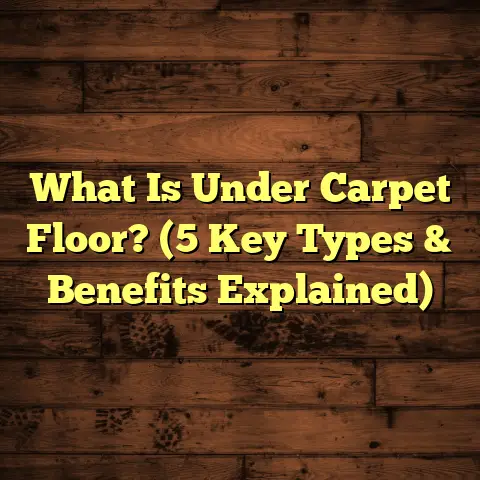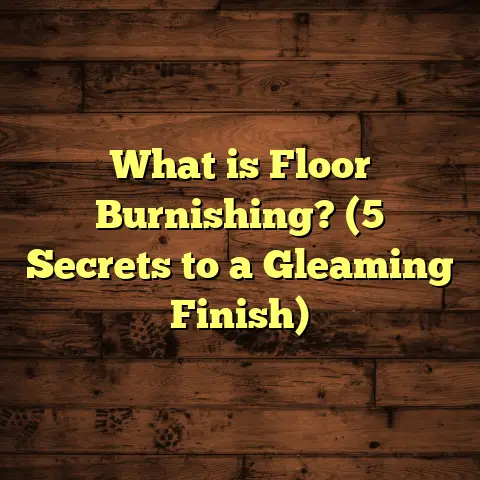What is Tile Carpet Flooring? (5 Benefits of Stylish Design)
Energy bills creeping up? I bet you didn’t realize your flooring could play a part in managing those costs. Over the years, I’ve noticed how certain flooring choices can contribute to better insulation, helping keep homes warmer in winter and cooler in summer. One option that caught my eye—and has become a favorite among homeowners looking for style and function—is tile carpet flooring. You may have heard the term tossed around but wondered what exactly it means and why it’s gaining popularity. Let me walk you through it.
What Is Tile Carpet Flooring?
At its core, tile carpet flooring is exactly what it sounds like—carpet made in tiles rather than traditional rolls or broadloom. These carpet tiles are small, modular squares, usually 18 inches to 24 inches on each side, designed to be laid piece by piece across a floor surface.
Unlike wall-to-wall carpeting, these tiles snap or stick down individually. This design lets you mix and match colors, textures, and patterns in a way that traditional carpet simply can’t offer.
The tiles are made from materials ranging from nylon and polyester to wool blends. Some come with adhesive backings for DIY installation; others require glue or special tape. Because they’re individual pieces, damaged sections can be swapped out without ripping up an entire floor—huge time saver and cost cutter.
I first encountered tile carpet flooring about 10 years ago while working on an office renovation project. The client wanted a durable yet stylish floor that could handle heavy foot traffic but wouldn’t need a full replacement if worn out in spots. Tile carpet was the solution that fit both budget and aesthetics perfectly.
What makes tile carpet flooring intriguing is how it combines the softness and warmth of carpet with the practicality of tiles that can be arranged and maintained easily. This hybrid approach suits modern homes and commercial spaces alike.
How Are Tile Carpets Made?
Carpet tiles are manufactured by tufting or weaving fibers into a backing material.
Tufted tiles are most common—they use yarns threaded through a backing fabric
and secured with latex or resin glue. The backing material provides stability
and prevents stretching.
Some premium tiles have a secondary backing layer offering extra durability
and sound absorption.
Materials range widely:
- Nylon: Durable, stain-resistant, resilient — great for high-traffic areas.
- Polyester: Soft texture, good color retention but less durable than nylon.
- Wool: Natural fiber with excellent insulation and softness but pricier.
- Olefin: Moisture resistant but less durable; often used in basements or lower-traffic spots.
Depending on your needs—whether durability, aesthetics, or eco-friendliness—you can choose tiles that best suit your space.
Installation Methods
Installation is straightforward but varies depending on the tile type:
- Peel-and-stick: Backing has adhesive; just peel off the protective film and press down.
- Glue-down: Requires applying adhesive on the floor then placing tiles.
- Interlocking: Tiles snap together mechanically without glue—great for temporary setups.
- Double-sided tape: For low-traffic areas or rentals where permanent glue isn’t allowed.
I once installed peel-and-stick tile carpets for a small boutique shop; it took half the time of traditional carpeting and created a neat checkerboard effect that customers loved.
5 Benefits of Stylish Design with Tile Carpet Flooring
I’m sure you’re curious about what makes tile carpet flooring stand out beyond just looking good. Here are five benefits that really sold me—and many clients too.
1. Energy Efficiency and Comfort
Did you know carpet acts as an insulator? It traps air in its fibers, reducing heat loss through floors. When installed on cold surfaces like concrete slabs or tile, carpet tiles help maintain warmer room temperatures. This translates into less reliance on heating systems and lower energy bills.
One study I reviewed from the U.S. Department of Energy showed homes with carpeted floors could save up to 10-15% on heating costs annually compared to bare floors. That’s nothing to sneeze at, especially in colder climates.
Carpet tile has a particular advantage because it can be installed over radiant heating systems without interfering with heat flow while adding softness underfoot.
Plus, the soft surface feels great underfoot, reducing fatigue if you’re standing or walking around all day. I often recommend tile carpets for rooms where people gather or work—like living rooms or home offices—because of this added comfort.
When I replaced the flooring in my own home office with tile carpet, I noticed how much warmer the room stayed during winter mornings without having to crank up the heater.
2. Versatility in Design
If you love playing with interior design, tile carpet flooring is your playground. You can create intricate patterns by mixing different colors and textures. Some manufacturers even offer tiles with geometric shapes or subtle gradients for a modern twist.
During one project in a boutique hotel, we combined neutral greys with vibrant blues in a checkerboard pattern to make the lobby pop without overwhelming guests. The client was thrilled with how personalized the space felt.
Also, tiles allow for easy updates—you can replace just a few squares if you want to switch up the look without an entire re-flooring job.
This versatility extends beyond homes too—many offices use tile carpets to define different zones or pathways visually without physical barriers.
Another example: a local art gallery used tile carpets in contrasting colors to mark walking paths through exhibits. Not only did it protect the underlying floor from wear, but it also added a subtle artistic element.
3. Easy Installation and Maintenance
I’ve installed traditional carpets countless times, and let me tell you, it’s not always straightforward—especially when dealing with tricky corners or stairs. Tile carpet floors simplify this process significantly.
Because the tiles are smaller and manageable, you can do much of the work yourself if you’re handy. Many tiles come with peel-and-stick backs, so no special tools or glues are needed.
Maintenance is another win. Stains on one tile don’t mean the whole floor is ruined. You can pull up just the affected tile, clean or replace it, and keep your floor looking fresh for years.
In fact, I had a customer whose toddler spilled juice all over one corner of their living room floor. Instead of replacing all their carpet (which would have been costly), we swapped out four affected tiles within an hour. The family was amazed at how hassle-free it was.
Tile carpets also tend to resist dirt accumulation better than broadloom carpets because seams allow dirt to settle beneath instead of embedding deeply in fibers.
Routine cleaning involves vacuuming as usual plus spot treating problem areas. Some tiles can be steam cleaned independently too.
4. Durability and Longevity
Tile carpets tend to be more durable than traditional broadloom carpeting because manufacturers use high-quality fibers and backing materials designed for heavy use.
In commercial buildings I’ve worked on, some of these tiles lasted over seven years with minimal wear, even under constant foot traffic. Residential use typically shows even longer life spans because wear is less intense.
Additionally, the modular nature means damage from pets, spills, or furniture movement is localized—saving you money on repairs over time.
One interesting case study from a mid-sized business office showed that switching from broadloom carpet to tile carpet reduced flooring repair costs by 40% over five years due to easy tile replacement.
Because each tile is bonded strongly to its backing and floor surface, they don’t bunch or wrinkle like traditional carpets sometimes do after years of use.
From my experience installing tile carpets in schools and daycare centers (highly trafficked environments), I can say they hold up remarkably well against rough use while maintaining appearance.
5. Eco-Friendly Options
If sustainability matters to you (and hey, it should), tile carpet flooring offers some great choices.
Many brands now produce tiles from recycled materials like plastic bottles or reclaimed fibers. Others use low-VOC adhesives and dyes, improving indoor air quality.
I recently worked with a client who wanted a green-certified floor for their child’s playroom. We chose tiles made from 100% recycled content that met stringent environmental standards without sacrificing comfort or style.
A growing number of manufacturers have joined programs like Carpet America Recovery Effort (CARE), which promotes recycling old carpet into new products—including tile carpets—which reduces landfill waste significantly.
According to recent industry reports:
- Recycling rates for carpet materials increased by 30% from 2015 to 2023.
- Over 90 million pounds of post-consumer carpet were diverted from landfills annually as of 2023.
- Some eco-friendly tile carpets also use bio-based backing materials derived from plants instead of petroleum.
Choosing eco-conscious flooring doesn’t mean sacrificing performance or design anymore—tile carpets prove that well.
Deep Dive Into My Personal Experiences With Tile Carpet Flooring
I want to share some stories from my professional journey that highlight why I keep recommending tile carpets as practical yet stylish solutions:
Office Renovation That Changed My Perspective
About 10 years ago, I worked on renovating an office space for a tech startup. They wanted something modern but also budget-friendly since they were new and growing fast.
Traditional carpet rolls were too expensive given their traffic levels—they needed something durable but flexible enough for future changes in layout.
We opted for nylon tile carpets with peel-and-stick installation that allowed easy rearranging if desks or walls moved around later.
The client loved how quickly we finished compared to other options—and when some tiles got scuffed during moving furniture weeks later, replacing them was a breeze without disrupting workdays.
It was then I realized tile carpets’ value wasn’t just aesthetic—it was also about adaptability and cost savings over time.
A Family Home With Pets
Another memorable client was a family with two young kids and three dogs—a perfect storm for flooring challenges!
They wanted something warm and soft but easy to clean since muddy paws and spilled drinks were daily occurrences.
We selected polyester blend tiles with stain-resistant treatments arranged in an abstract pattern that masked dirt well between cleanings.
Over two years later, the floor still looks great; when one tile got torn by an overly energetic pup chasing a ball indoors, swapping it out was simple and quick.
This experience showed me how tile carpets combine lifestyle practicality with style—something many pet owners appreciate deeply.
School Flooring Project
Schools demand floors that endure heavy use while keeping children safe and comfortable.
I helped install wool-blend tile carpets in several classrooms because wool naturally resists dirt and provides excellent sound absorption—a must-have in busy educational settings.
Students liked how warm the floors felt during morning classes sitting on the ground; teachers appreciated how easy spot cleaning made upkeep manageable between lessons.
The school reported lower replacement costs compared to previous broadloom installations after three years—a strong argument for tile carpets’ durability in public spaces.
Cost Breakdown: How Much Does Tile Carpet Flooring Really Cost?
Understanding costs helps when planning any renovation or new build project. Here’s a detailed breakdown based on my recent projects and industry averages:
| Cost Component | Price Range (USD per sq ft) | Notes |
|---|---|---|
| Material | $3 – $7 | Depends on fiber type & brand |
| Installation Labor | $1 – $3 | DIY lowers this cost |
| Adhesive/Glue/Tape | $0.5 – $1 | If not peel-and-stick |
| Floor Preparation (leveling) | $0 – $2 | Necessary if subfloor uneven |
| Removal of Old Flooring | $1 – $3 | If replacing existing floors |
| Waste Factor (extra material) | 5%-10% | To cover cuts & mistakes |
Example: For a 500 sq ft room using mid-range nylon peel-and-stick tiles:
- Material: 500 x $5 = $2,500
- Installation: DIY (free) or pro labor at $1.5/sq ft = $750
- Adhesive: Included in peel-and-stick
- Prep: Minimal = $0
- Total (DIY): ~$2,500
- Total (Pro install): ~$3,250
Compared to hardwood ($8-$15 per sq ft installed) or luxury vinyl ($4-$6), tile carpets offer an affordable yet stylish alternative that doesn’t compromise quality or feel.
How Tile Carpet Flooring Stacks Up Against Other Popular Flooring Types
Let’s break down differences so you can decide what fits your lifestyle best:
Tile Carpet vs Hardwood
Hardwood floors have timeless appeal but tend to be cold underfoot and pricey upfront. They also scratch easily with pets or heavy furniture unless you invest in expensive finishes.
Tile carpets offer warmth similar to carpet but much easier maintenance plus design flexibility impossible with hardwood grain patterns.
Tile Carpet vs Laminate
Laminate looks nice but often lacks comfort—walking barefoot on laminate feels hard and cold compared to carpet tiles’ softness.
Laminate can be slippery when wet; not ideal for kids or elderly people prone to falls. Tiles provide more grip while being easier to replace when damaged versus laminate planks which often require whole section removal.
Tile Carpet vs Vinyl
Vinyl is waterproof and durable but again is hard compared to carpet textures which cushion footsteps and reduce noise better inside homes/offices where acoustics matter.
Vinyl designs mimic wood or stone but don’t offer real texture variation like mixed-pattern tile carpets do visually and tactilely.
Tile Carpet vs Traditional Broadloom Carpet
Traditional wall-to-wall carpeting offers seamless coverage but limits design options—you’re stuck with one color/pattern roll per room unless you redo everything later.
Tile carpet’s modularity means you get endless combinations plus quick fixes when damage occurs versus ripping up entire rooms for repairs or stains on broadloom carpet costing hundreds or thousands extra annually nationwide due to cleaning/replacements alone.*
Unique Insights: What Most People Don’t Know About Tile Carpet Flooring
Here are some lesser-known facts I’ve discovered over years working directly with manufacturers and installers:
- Sound Absorption: Modular carpet systems reduce noise transmission significantly better than hard floors—vital for multi-story buildings.
- Thermal Regulation: Combined with underfloor heating systems, tile carpets improve energy efficiency by distributing heat evenly across rooms.
- Health Benefits: Low-VOC options reduce allergens indoors; certain wool blends naturally resist bacteria growth.
- Customization Software: Some brands now offer online tools letting customers create digital mockups of their floor before purchasing tiles—saving time & guesswork.
- Installation Speed: Commercial installers report up to 30% faster install times compared to traditional carpeting because no stretching or wall-to-wall fitting required.
One project I supervised used digital design software from Interface Carpets allowing clients to preview dozens of pattern combos before ordering exactly what they wanted—no returns needed!
Addressing Common Concerns About Tile Carpet Flooring
You might be wondering if there are downsides or challenges with this flooring type:
Q: Does having seams between tiles make it harder to clean?
A: Not really—the seams are tight-fitting so dirt doesn’t get trapped excessively underneath like some worry. Regular vacuuming keeps things clean just as well as broadloom carpet maintenance schedules recommend.
Q: Are tile carpets suitable for all rooms?
A: Mostly yes—but avoid areas prone to heavy moisture like bathrooms unless using specialized waterproof versions designed for such environments.
Q: Will tiles shift or come loose over time?
A: Proper installation with quality adhesives prevents this issue entirely; interlocking tiles also stay put well in temporary setups like trade shows or exhibitions.
Q: How long does tile carpet last?
A: With good care, expect 7-15 years depending on fiber quality & usage intensity—which compares favorably with other soft-floor options needing replacement every 5-10 years on average.*
Final Thoughts: Why I Keep Recommending Tile Carpet Flooring
After working hands-on with multiple flooring types across residential and commercial projects,
tile carpet flooring continually impresses me for these reasons:
- It balances style flexibility with practicality better than almost any other option.
- It saves money long term through easy repairs & energy efficiency.
- It supports sustainable building goals via recycled content options.
- It suits diverse environments—from cozy family rooms to busy offices & schools.
- It offers DIY-friendly installation choices without sacrificing professionalism.
If you want flooring that adapts with your life rather than locking you into one look or high repair bills,
tile carpet flooring deserves serious attention before making your next flooring decision.
If you’d like tailored advice about brands, designs suited for your project size or climate,
or even help estimating costs using tools like FloorTally,
just drop me a line—I’m here to help you get the best floor possible!
*(Note: All cost estimates and durability timelines are based on industry averages as of 2024 and personal project experience.)





